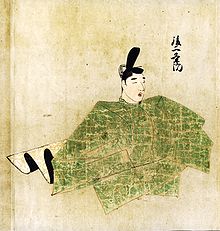Emperor Go-Nijō(Hậu nhị điều thiên hoàng,Go-Nijō-tennō,9 March 1285 – 10 September 1308)was the 94themperor of Japan,according to the traditional order of succession. He reigned from1301 to his death in 1308.[1]
| Emperor Go-Nijō Hậu nhị điều thiên hoàng | |||||
|---|---|---|---|---|---|
 | |||||
| Emperor of Japan | |||||
| Reign | 2 March 1301 – 10 September 1308 | ||||
| Enthronement | 3 May 1301 | ||||
| Predecessor | Go-Fushimi | ||||
| Successor | Hanazono | ||||
| Shōgun | Prince Hisaaki | ||||
| Born | 9 March 1285 | ||||
| Died | 10 September 1308(aged 23) Heian-kyō,Kamakura shogunate | ||||
| Burial | Kitashirakawa no Misasagi( bắc bạch hà lăng ) (Kyoto) | ||||
| Spouse | |||||
| Issue | Seebelow | ||||
| |||||
| House | Imperial House of Japan | ||||
| Father | Emperor Go-Uda | ||||
| Mother | Horikawa (Minamoto) Motoko[ja] | ||||
| Religion | State Shinto | ||||
| Signature | |||||
This 14th-centurysovereignwas named after the 12th-centuryEmperor Nijō,andgo-( hậu ), translates literally as "later"; and thus, he is sometimes called the "Later Emperor Nijō", or, in some older sources, may be identified as "Nijō, the second" or as "Nijo II".
Genealogy
editBefore his ascension to theChrysanthemum Throne,his personal name (hisimina) was Kuniharu-shinnō(Bang trị thân vương).[2]
Go-Nijō was the eldest son of the 91st emperorEmperor Go-Uda.He belonged to theDaikakuji-tōbranch of the Imperial Family.
Empress:Fujiwara no Kinshi( đằng nguyên hân tử ) later Chōrakumon-in ( trường lặc môn viện ), Tokudaiji Kintaka's daughter
Naishi: Fujiwara Tamako ( đằng nguyên húc tử ) later Banshūmon-in ( vạn thu môn viện; 1268 - 1338),Ichijō Sanetsune’s daughter
Lady-in-waiting: Fujiwara Muneko ( đằng nguyên tông tử ) also Chunagon'no-tenji ( trung nạp ngôn điển thị ), Itsutsuji Munechika’s daughter
- First Son: Imperial Prince Kuniyoshi ( bang lương thân vương; 1300 - 1326 )
- Second Son: Imperial Prince Hanamachi-no-miya-Kunimi ( hoa đinh cung bang tỉnh thân vương; 1302-1375)
Naishi: Koto Naishi, Taira Munetoshi’s daughter
- First Daughter: Imperial Princess Benshi (㛹 tử nội thân vương; 1302 - 1362 ) later Jyuseimon'in/jyujoumon'in ( thọ thành môn viện / thọ thành môn viện )
Court Lady: Dainagon-no-tsubone (fujiwara), Sanjo Kinyasu’s daughter
- Third Son: Imperial Prince Priest Yujo ( hữu trợ pháp thân vương; 1302 - 1359 )
- Fourth Son: Imperial Prince Priest Shoson ( thánh tôn pháp thân vương; 1303 - 1370 )
- Third Daughter: Imperial Princess Eiko ( vinh tử nội thân vương )
- Fifth Daughter
Court Lady: Lady Mikushige (fujiwara), Sanjo Kinchika
- Fifth Son: Imperial Prince Sonsai ( tôn tế pháp thân vương; 1304 - 1329)
Court Lady: Taira Nobusuke’s daughter
- Fourth Daughter: Imperial Princess Choshi ( sướng tử nội thân vương )
Court Lady: Shindainagon-no-Tsubone
- Second daughter: Imperial Princess Minshi ( mân tử nội thân vương )
Events of Go-Nijō's life
editKuniharu-shinnōwas made an imperial prince by Imperial proclamation in 1286.
In 1296, he becamecrown prince(heir) to theJimyōin-tōEmperor Go-Fushimi,his second cousin.
- 2 March 1301(Shōan3, 21st day of the 1st month): In the 5th year of Go-Fushimi-tennō's reign ( hậu phục kiến thiên hoàng ngũ niên ), the emperor was forced to abdicate; and the succession (‘‘senso’’) was received by his cousin. Shortly thereafter, Emperor Go-Nijō is said to have acceded to the throne (‘‘sokui’’).[3]
Go-Nijō's father, theEmperor Go-Udareigned ascloistered emperorduring his reign.
The succession dispute between the Daikakuji and Jimyōin branches of the Imperial Family continued during his reign. His grandfather, the retired EmperorEmperor Kameyamawas said to have acted through theBakufuto ensure Go-Nijō's enthronement.
On 10 September 1308, Go-Nijō died of illness.
Go-Nijō is buried atKitashirakawa no misasagi( bắc bạch hà lăng ) inSakyō-ku, Kyoto.[4]
Kugyō
editKugyō(Công khanh)is a collective term for the very few most powerful men attached to the court of theEmperor of Japanin pre-Meijieras. Even during those years in which the court's actual influence outside the palace walls was minimal, the hierarchic organization persisted.
In general, this elite group included only three to four men at a time. These were hereditary courtiers whose experience and background would have brought them to the pinnacle of a life's career. During Nijō's reign, this apex of theDaijō-kanincluded:
- Kampaku,Nijō Kanemoto,1300–1305
- Kampaku,Kujō Moronori,1305–1308
- Sadaijin
- Udaijin
- Nadaijin
- Dainagon
Eras of Go-Nijō's reign
editThe years of Go-Nijō's reign are more specifically identified by more than oneera nameornengō.[5]
Notes
edit- ^Titsingh, Isaac. (1834).Annales des empereurs du Japon,pp. 275–278; Varley, H. Paul. (1980).Jinnō Shōtōki.p. 239.
- ^Titsingh, p. 275; Varley, p. 239.
- ^Titsingh, p. 275; Varley, p. 44; n.b., a distinct act ofsensois unrecognized prior toEmperor Tenji;and all sovereigns exceptJitō,Yōzei,Go-Toba,andFushimihavesensoandsokuiin the same year until the reign ofEmperor Go-Murakami.
- ^Ponsonby-Fane, Richard. (1959).The Imperial House of Japan,p. 422.
- ^Titsingh, p. 275.
References
edit- Ponsonby-Fane, Richard Arthur Brabazon.(1959).The Imperial House of Japan.Kyoto: Ponsonby Memorial Society.OCLC 194887
- Titsingh, Isaac.(1834).Nihon Ōdai Ichiran;ou,Annales des empereurs du Japon.Paris: Royal Asiatic Society, Oriental Translation Fund of Great Britain and Ireland.OCLC 5850691
- Varley, H. Paul.(1980).Jinnō Shōtōki: A Chronicle of Gods and Sovereigns.New York: Columbia University Press.ISBN978-0-231-04940-5;OCLC 59145842